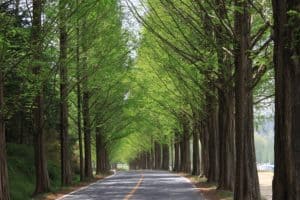Sun Requirements
Full sun
Bloom Period and Seasonal Color
Grown mostly for its large stature, fall yellow needle color and interesting colored bark
Mature Height x Spread
70 to 90 feet x 15 to 25 feet
Added Benefits
tolerates clay soil, wet soil air pollution, deer resistant
This magnificent tree dates back to the dinosaur age and was thought to be extinct until discovered in China in the 1940s. Like the tamarack, it’s a conifer, but drops its needles in fall. Mature trees have the look of the giant sequoia, but are hardier. Dawn redwood grow in wet, clay soils and tolerate air pollution, making it a good park tree in cities. However, because of its size, it needs plenty of room to spread. The light green, finely cut foliage turns darker green in summer and golden colored in fall. The cones are small and no significant. The trunk flutes with age and has attractive orange and brown textured bark.
When, Where and How to Plant
Dawn redwood trees are hardy in zones 4 to 8, offering a wide range of locations across the country to grow this beautiful specimen. Purchase trees from local nurseries and plant in spring to early fall in full sun on well-drained, humus-rich, consistently moist soils. Space trees 25 or more feet apart. Young trees can be grown in containers.
Growing Tips
Keep trees well watered or grown in locations that stay moist all summer. They can be good rain garden trees. Dawn redwoods don’t appreciate drought and can drop their foliage prematurely during dry conditions. Create a mulch ring around the base of young trees planted in lawns covered with bark mulch and wood chips to maintain soil moisture conditions and to help reduce damage to the trunk due to lawn mowers and string trimmers. Dawn redwoods grow best in slightly acidic soil and don’t like alkaline soil.
Regional Advice and Care
Dawn redwoods are care-free trees if grown in the proper location. The conical shaped tree grows quickly with adequate moisture and has few pests and diseases. Other than adding compost annually and mulching to maintain soil moisture, dawn redwoods require little fertilizer. They only require pruning to remove dead, diseased or broken branches.
Companion Planting and Design
Plant dawn redwoods trees along a stream bed, the edge of woodlands, in a park or in a meadow. These large trees need room to grow to look their best. Because of their tolerance to pollution, they are good city trees, as long as they have enough root and top space. Plant dawn redwood in open areas with native trees that like similar growth conditions. I once saw a beautiful stand of dawn redwoods interplanted with river birch. The contrast of the bark colors and textures and tree shapes was stunning, especially in winter.
Try These
There are only a few, different selections of dawn redwood available to gardeners. Most dawn redwoods are the species types with green foliage and a towering growth habit. The most common exception is ‘Gold Rush’. This variety has golden foliage all summer and grows only 50 feet tall with a more narrow stature.



